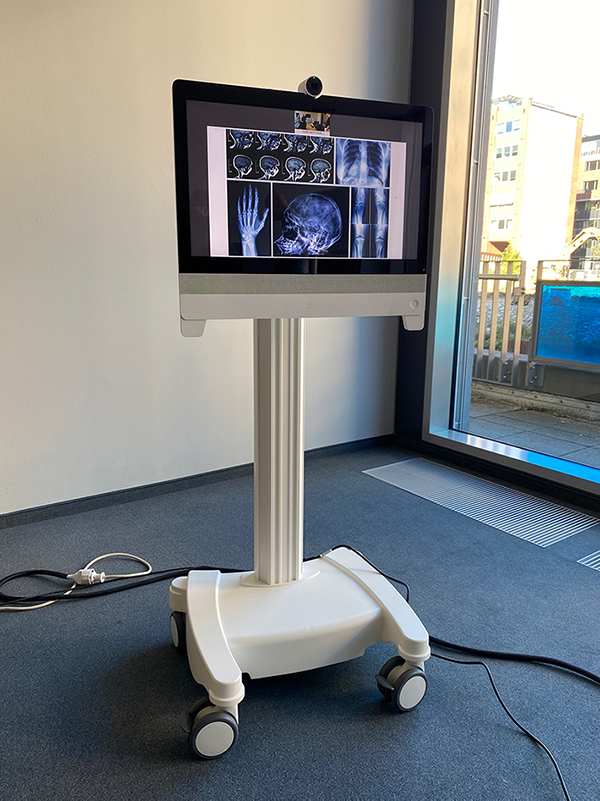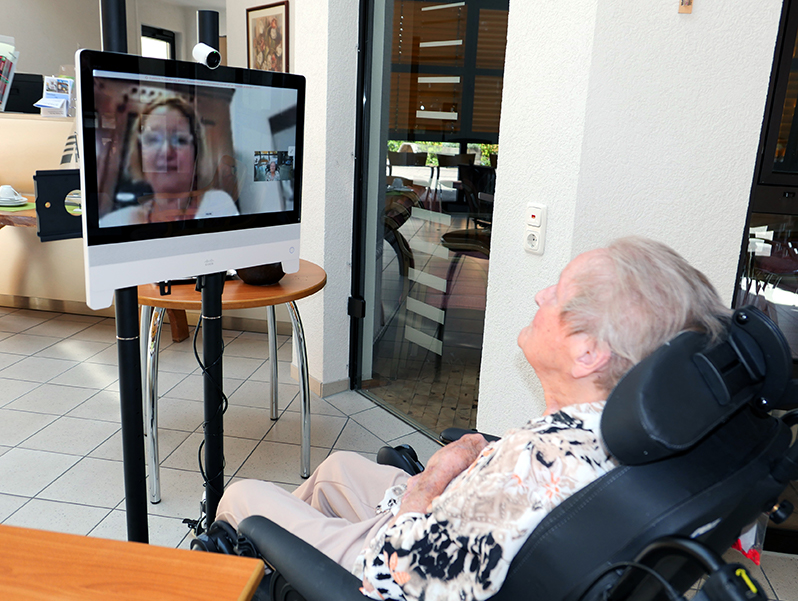Connection and Care: Designing the Future of Accessible Video Communication
Cisco
The global pandemic has exposed and exacerbated existing issues within society, particularly those that afflict the most vulnerable among us. It’s how we respond to those issues that defines our society’s values—do we build walls or do we build bridges?
I'm proud to say that for more than 20 years, avodaq has been building bridges. We started out in Hamburg back in 1997 as a training provider, focusing on Cisco products.
Over time, avodaq transformed from a training company to a classic systems integrator and is now a digital business partner. We grew from two partners to a team of more than 200 people, but we’ve remained a Cisco-focused partner, solving our customers’ problems by using Cisco technology.
Solving Problems in the Social Sector
In 2016, avodaq faced a defining moment. The refugee crisis swept through Europe, and Germany experienced unprecedented waves of immigration. Many refugees entering our borders suffered from traumatic experiences, but language barriers made it difficult for them to get the help they needed.
Seeing the need for a bridge, our company decided to take on projects in the social sector. Addressing issues in this area was nothing like selecting a pre-configured Cisco solution; often no pre-made solution existed and we had to develop our own.
In this case, we came up with the Refugee First Response Center, a mobile medical clinic that connects physicians and refugees via video conference to a translator or interpreter so they can connect and communicate on a meaningful level. By continuing to work on projects like the Refugee First Response Center, avodaq evolved beyond a typical systems integrator—we became a socially conscious digital business partner for various organizations.
I started at avodaq three years ago working on change management as customers integrated new Cisco software solutions. The team focused on the human side of IT integration, including training user groups and communication campaigns. Earlier this year, I stepped into the new role of digital business manager. I’m now responsible for projects that require additional business process and development resources beyond those of traditional system integrations.
The pandemic reached Europe in March 2020, and we were soon in a full-scale lockdown. By April, we had our next project: connecting those in elder care with their families.
Bridging the Gap Between Elder Care and Technology
The idea came from my personal pain. The nursing facility where my grandmother lives was completely closed to visitors. Talking on the phone wasn’t even a viable alternative because hearing aids make it difficult to hold a phone next to the ear. The enforced distance devastated my family, and we were worried about the impact this would have on my grandmother.
We scrambled to provide a workaround. We gave the nursing facility an iPad with a cellular component so we could stay connected with my grandmother. It wasn’t great, but it was a start.
German private companies are digitally literate and well-equipped, but the social and public sectors are not so fortunate. Broadband connectivity is still limited across rural Germany. That, coupled with the fact that the social and public sectors are tied to longer innovation cycles, meant many long-term care facilities lacked building-wide Wi-Fi and other digital assets.
Additionally, elder care is a very human-focused job. Caregivers don't necessarily want to care about technology; they want to care for people. Recognizing this, we wanted to make it as easy as possible for them to facilitate our family’s calls. We used Skype or FaceTime on the iPad, which we configured to auto-answer calls. We eliminated extraneous notifications and buttons, making the iPad as simple to use as possible.
That worked for a few weeks, but helping residents receive calls interrupted the workflow of the staff. When we called for my grandmother, a caregiver had to stop what they were doing to see if she was available and in a state where she was ready and able to chat. If she was, great. If not, we’d have to try again another time.
Even though the staff was supportive, the setup wasn’t practical for the long term, nor was the solution scalable. Of course, we weren’t the only family in Germany facing the same situation. It only made sense for avodaq to look at technology as a way to overcome the separation, building a bridge from one industry to another.
A Digital Bridge Using Cisco Solutions
We obviously know Cisco solutions extremely well, and I knew video communication devices like the Cisco DX80 or the Cisco Webex Desk Pro could replace the iPad because they have a one-button feature purpose-built for meetings.
But we also had to find a way to stop interrupting the processes of the nursing facilities. So we worked with our software developers to write a connection between Cisco Webex and an online appointment booking calendar. We provided the nursing facility with access to this calendar so they could define a resident’s availability for video calls, limit call duration, set buffer times between calls, and establish the maximum number of calls daily. This configurable calendar helped create order so that staff didn’t have to coordinate any calls and could focus on their caring responsibilities.

The current model. (Source: avodaq)
We connected everything through a 4G LTE module so the facility didn’t need to install building-wide Wi-Fi. Even though there were many distinct components, it appeared and operated like one pre-configured solution for making video calls.
Configuration and customization is something Cisco does better than anyone else. We could also make configurations standard and push them across a whole range of devices within a few minutes, as well as automate that process.
We also had to consider GDPR compliance and user data protection. As elder care falls partially within the healthcare sector, protecting specific personal data is part of healthcare data compliance as well. In Germany, we also have the Federal Office for Information Security (BSI), a German public agency that certifies solutions according to data protection needs, among other things. Cisco Webex is one of the few communication solutions in Germany that has the BSI C5 certificate, and this high security standard was another strong point in Cisco’s favor.
The facilities’ IT administrators obviously want a solution that fits into their data protection scheme. Using Webex, we could provide them with all the necessary documentation to prove our solution holds data protection as a central part of its operation.
The Evolution of a Solution
We went through several iterations to get to the current videoconferencing solution. We asked nursing facilities around Hamburg, Giessen, and Berlin to test our solution and give us feedback. Six facilities agreed to participate in a trial.
We initially considered just putting the device into a designated video call room but that wasn’t possible in any of those six nursing facilities. Our device had to be mobile so staff could transport it between residents’ rooms. This way, the call could be private and wouldn’t require constant assistance from staff.
We spoke with various trolley manufacturers to slim down the design and keep it mobile so it could move around easily. We also had to ensure it was sturdy so it wouldn’t ever be in danger of falling on a resident. We had some initial design revision, but the feedback from our participating medical personnel was invaluable.
This was new for all of us, and there was no standard process to design, configure, ship, and onboard all the administrators and users—many of whom had no prior technical experience. It was scrappy in the beginning but we’ve since simplified and streamlined the process. The devices are now all delivered pre-configured, so all facilities have to do is unpack it and plug it in. We also moved to a completely managed service approach and are very flexible with how each facility needs to order, take delivery, and manage payments. We can even handle calendar control if desired.
I was initially nervous that we had overstepped and attempted to solve a human problem with a technical solution, but by refining the design and remaining focused on our goal, we found a way to put the right pieces in place.
CARY Puts People First
Throughout the process, we knew we needed to give our device a name. We wanted something that acknowledged the care sector, and wanted to highlight the fact that the solution cares about the communication between people. It wasn’t long before nurses and staff at the long-term care facilities started talking about our solution as though it was a person: “Let me see if CARY is available,” or “I’ll go get CARY.” CARY became a routine part of life at some facilities, and as the care providers became increasingly familiar with it, the name stuck.
In Germany, people can be cautious about new developments and solutions. They’re loyal to whatever worked well in the past, and it can be a challenge to overcome this loyalty when introducing a new solution into the German market.
At first, elder care facilities were cautious about adopting our solution, largely because of the technology involved. But once they started to see how CARY brought families together and how easy it is to use, they became invested and even enthusiastic about what it can do. After a few weeks of using CARY, our customers had a lot of positive feedback.

The first pilot. (Source: Caritasverband Gießen)
The best feedback we got was from a nursing facility in Berlin, where they just wrote two lines in an email: “The device worked great. Everyone cried.”
Germans are typically rather reserved, so to have created a device that provokes such strong emotional reaction lit everyone up at avodaq.
Transforming Elder Care for Generations to Come
Germany has 14,000 nursing facilities and most of them do not have any video communication capabilities. They mostly rely on audio solutions or have no solution in place at all. We've introduced CARY now to 15 facilities and are growing. Each device is used for two to five calls a day, usually five days a week. We’re also in talks with a couple of facilities about providing a complete video communication room and expanding their use of CARY beyond family calls.
This project has highlighted just how important it is to make connections whenever and wherever possible. Cisco has long claimed that they build bridges where there were none before, and that was the case in just about every facet of this project.
CARY built bridges between the residents and their relatives, between different manufacturers and companies that had never before collaborated, and between the elder care sector and the technology sector.
Cisco enabled us to move communication into individual’s private spaces so we could continue talking to each other under drastic circumstances. Even when the pandemic eventually subsides, the inroads we are making now will increase the digital offerings to the elder care sector in the future. It isn’t an understatement to say that technology changes lives for the better. It certainly has done so for some of the most vulnerable members of our population.







